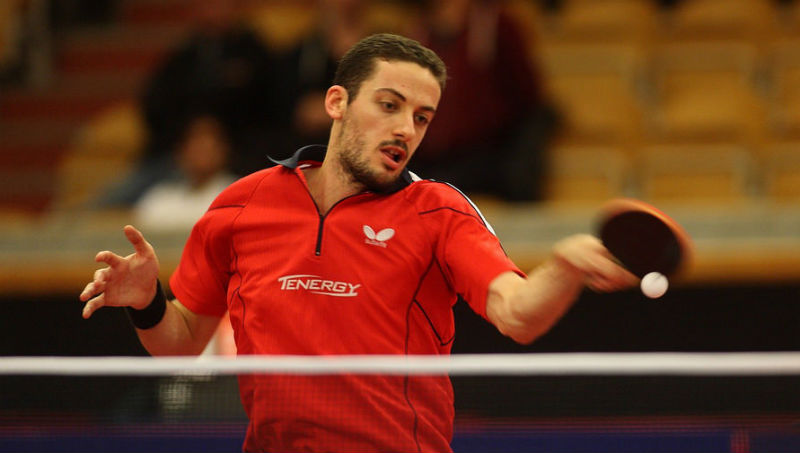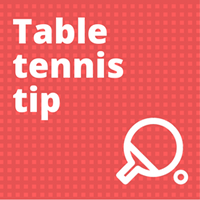
To be really good at table tennis, you need to be able to attack. The best players in the world are attackers. The best players in local leagues and amateur tournaments are attackers. Even the top defenders have strong attacks too. When you attack, you give your opponent something to worry about. You have more control over the rally. In most cases, you have more chance of winning the point.
But how to do it? Players learning the game (and also some players who have been playing for 30 years) can find it difficult to attack during matches. Is this you? You may have the aspiration to attack. You may tell yourself that you want to attack. But the opportunity never seems to present itself, especially against a better player who doesn’t give you any easy balls to smash away.
So let’s look at how you can attack more….
Get your attack in early
Most table tennis points are over within the first five shots (read this blog post for more about this). If you haven’t played an attacking shot in balls 2, 3, 4 or 5, you may not get an opportunity. Most of the time, the point will already be over.
If you like to push, push, push, push, push and and wait for an easy ball to attack, you’ll always struggle to be an attacking player. You need to stop pushing and start attacking much earlier.
There are two simple ways of doing this.
1. Focus on 3rd ball attacks
There is a certain amount of predictability with how an opponent will return your serves, especially at lower levels. Don’t wait to see how your opponent returns your serve. You should anticipate how your opponent will return your serve. When you focus on how your serve will be returned and the likely position(s) it will be returned to, it is so much easier to prepare for a 3rd ball attack.
For example, I often serve sidespin cross-court to my opponent’s backhand. I know 90% of the time, the ball will be return to backhand half of table. How do I know this?
- The sidespin on the serve makes the ball kick back to my backhand side.
- If an opponent is not expecting a serve, they will usually return the ball in the direction it came from.
- Players usually try to avoid my forehand, so will go to my backhand where possible.
So I know when I do this serve, there is a very good chance it will be returned to the backhand half of the table. I anticipate this will happen. Then what do I do? After I serve, I position myself in the backhand corner and attack the 3rd ball with my forehand (my stronger side). If I make the attack, most of the time I win the point. Job done.
Think about your own serves. You probably have a good idea about which serves are returned in a predictable way. These are the serves you should focus on. Now think about where you need to position yourself to get ready to attack the 3rd ball. Put the two together and you’ll find it much easier to attack the 3rd ball.
2. Attack your opponent’s serves
Most serves can be attacked, either with topspins or flicks. This is definitely true at lower levels, where players don’t disguise their serves at all. Even at higher levels, most serves can be attacked, as long as you can read the spin (which admittedly is easier said than done).
Your opponent serves sidespin, you can topspin it. Your opponent serves long backspin, you can topspin it. Your opponent serves topspin, you can topspin or drive it. Your opponent serves short, you can flick it.
You don’t have to blast the ball or do spectacular topspin attacks. It’s better to keep your strokes short and do controlled attacks, as you’ll have much higher consistency. By attacking serves, you put your opponent on the back foot straight away. You rush your opponent. You force your opponent to be more passive. And then you’ll find it easier to keep attacking.
How do you get good at attacking serves? One answer, and one answer only: PRACTISE.
A good exercise to do is to get your partner to keep serving at you. You’re not allowed to push or block any serves. You have to play an attacking shot. You partner can serve any spin, to any position, but you have to attack. You can start with just the service and return of serve. But as you feel confident, you should play out the point and see if you can attack the serve and the next ball too.
You may need to do this for a few months, with different players, but eventually you’ll feel much more confident. And you should find it quite liberating, as there is far less decision-making. Whatever serve your opponent gives you, you’re going to attack. No need for any indecision.
Attacking mindset
To attack more, you need to approach your matches with an attacking mindset. It’s no good adopting a ‘wait-and-see’ attitude, e.g. I’ll just see what my opponent plays like before deciding if I should attack or not. If you do this, the match may slip away before you even get a chance to start attacking.
Right from the first point, you should try to attack. Be prepared to lose a few points early on through missed attacks. This is ok. It can take a few points to shake off the early match tension. You need to find your range and attacking rhythm. When you find a rhythm, those missed attacks will start hitting the table.
By attacking right from the start – whether you miss or hit – there is a good chance you will force your opponent into a passive style of play. And when your opponent starts playing passively, it becomes so much easier to keep attacking. Your opponent pushes and blocks, you topspin and hit. In this situation, that attacker will win far more often than the passive player.
Confidence
Finally, a word on confidence. To have any chance of being a good attacking player, you must have confidence in your strokes. You need to be able to consistently attack both topspin and backspin balls. It’s not essential that you can do this with both your forehand and backhand (although this helps), but you must be able to attack both types of spin with at least one side.
If you have no confidence in your attacking strokes, you’ll always find it difficult to attack during matches. You’ll miss one or two attacks and then stop attacking. The risk-averse part of your brain will take over and you’ll opt for safer options like pushing and blocking.
How do you know if you have confidence in your attacks? I explain it to the players I coach in this way…
If you attack and you’re surprised the ball goes on the table (ooh, the ball went on!), you have low confidence. You weren’t expecting to make the shot, because you normally miss. It was a pleasant surprise that it worked.
If you attack and you’re surprised you missed (I can’t believe I missed that), you have higher confidence. Your normally make that shot and even though you missed this one, it’s not going to put you off attacking again, as you’re pretty sure you’ll make it next time.
You need to reach the stage where you have high confidence in your strokes, where you expect to make the attack every time. If you’re not at this stage yet, you need to go back to the practice table and do lots of training drills. This is how the best players got so good. They just practised their attacking strokes over and over again, until they just didn’t miss. To get good at attacking, you need to do the same.


